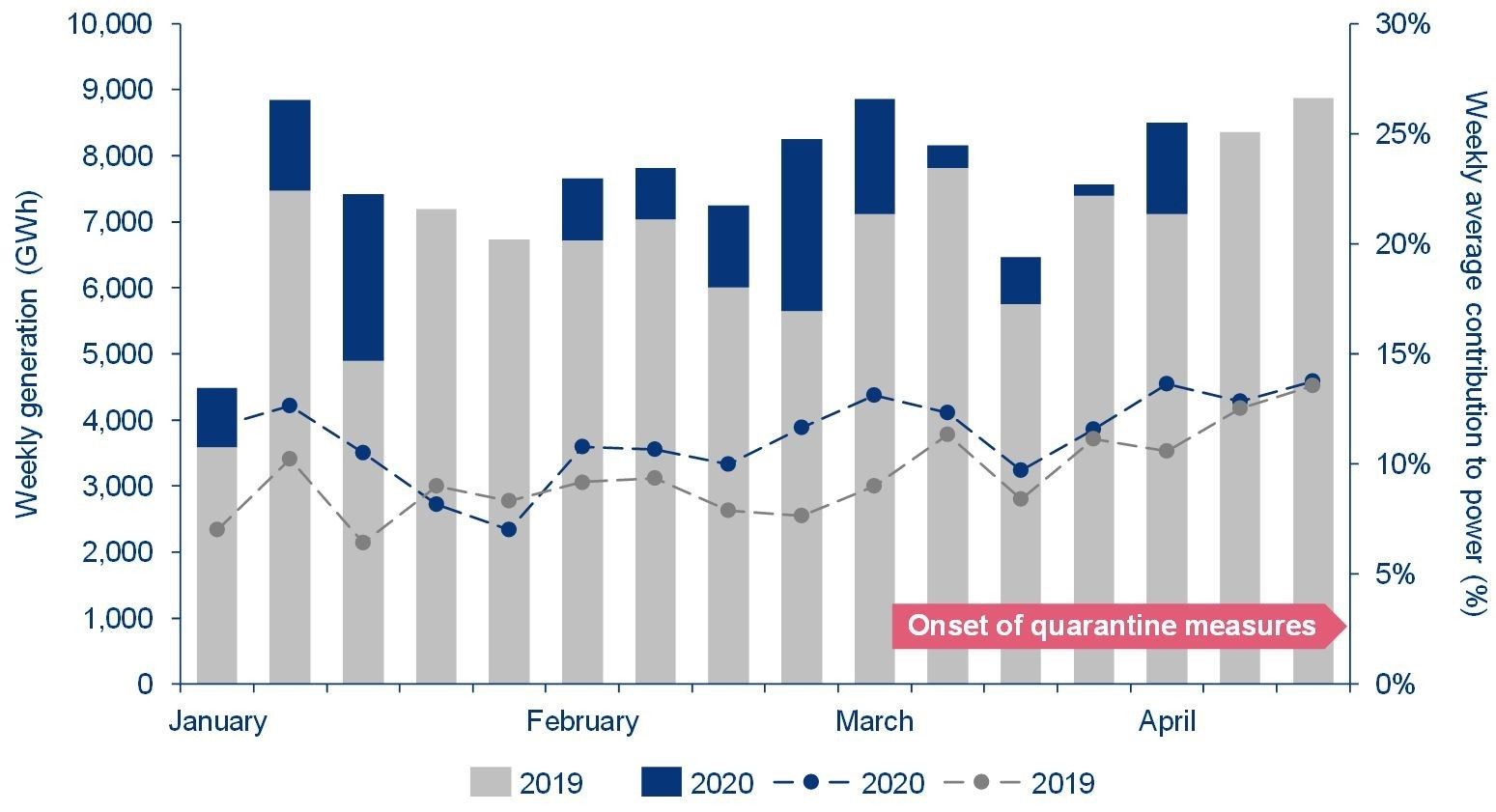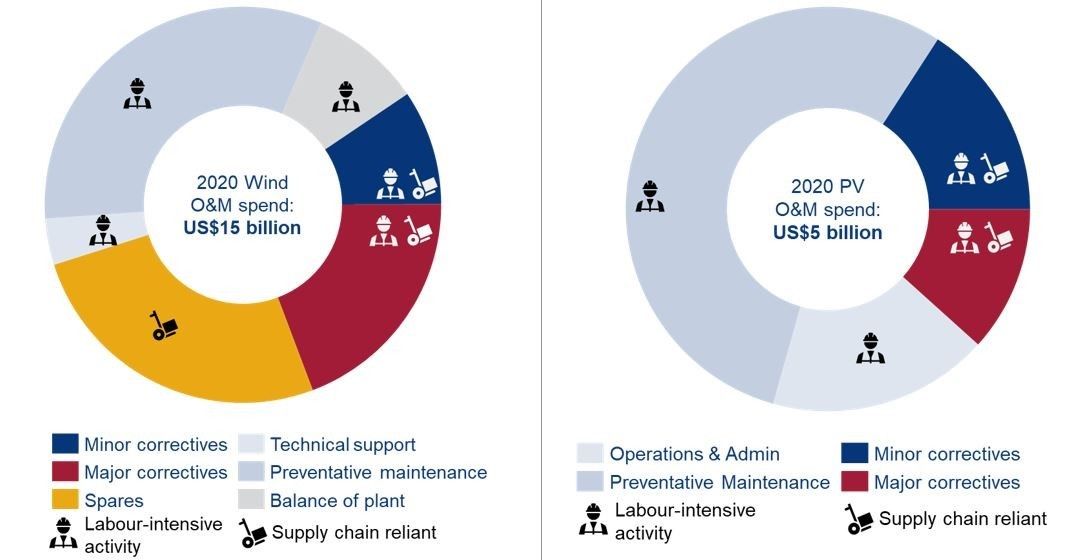
Digital tools such as analytics and remote monitoring will get a boost as wind and solar plant operators draw lessons from the lockdown.
Renewables generation has proven largely resilient during the COVID-19 pandemic. Even as global electricity demand has declined, wind and solar PV penetration continues its growth in many regions.
In the U.S. — one of the countries worst-affected by COVID-19 — wind and PV output is 10 percent higher on a year-to-date basis than in 2019.

Keeping wind and PV plants operational requires a considerable effort. COVID-19-affected countries have adopted measures to protect electricity supply, including renewables. Therefore, there is increased scrutiny on the $20 billion global solar and wind operations and maintenance market as service providers, manufacturers, generators and utilities strive to ensure plant availability.
The O&M sector’s immediate COVID-19 challenges
Industry players are concerned about two main challenges right now: supply-chain constraints and health and safety protocols required to contain the virus spread.
The renewables O&M value chain depends heavily on global manufacturing networks to deliver critical spare parts. China was first to shut down its facilities to combat the coronavirus infection. The closure of Chinese manufacturing and distribution cascaded throughout the renewables industry, hampering manufacturers and service providers reliant on Asian partners in their supply chains. While China has largely resumed activities, other regions crucial to renewables manufacturing remain in lockdown.
Spare-parts distribution is an area of concern for the renewable energy aftersales market. Delays in spares delivery can extend downtime in some cases and potentially put a project’s revenue at risk. So far, however, the renewables service sector has suffered limited disruption.
Another COVID-19 concern for the O&M sector relates to physical distancing protocols. Such distancing requirements impact a service team’s efficiency, crew travel expenses and overall planning. Administrative costs have also increased.
Technician health and safety are key for asset owners as they move to keep their wind and solar farms up and running during the health crisis. O&M service providers — from contractors to manufacturers — must meet not just government quarantine measures but also asset owners’ occupational health and safety obligations.

Keeping wind and solar plants up and running is a $20 billion annual business globally. (Credit: Wood Mackenzie)
Wood Mackenzie sees asset owners adopting two distinct O&M strategies during the crisis. The strategies are not being used universally across a region but rather are adapted on a case-by-case basis.
1. Limiting O&M to critical activities
Owners relying on contracted service providers, with reduced crew on-site, will likely focus the limited — but specialized — team of technicians on only the most critical activities.
Corrective maintenance with a strong impact on plant operations, such as a Category 5 blade repair on a wind turbine or a central inverter replacement in a solar utility project, will be prioritized to ensure plant uptime.
2. Prioritization of preventative maintenance using existing on-site staff
Major corrective activities typically involve two-person teams working in confined spaces. As such, corrective repairs requiring close physical proximity and/or external technician visits may be indefinitely deferred until the coronavirus situation resolves.
Self-performers with flexible in-house staff are expected to follow this approach given that project sites are considered a controlled environment — if no external staff is allowed. Limiting external contractors helps operators to protect their personnel and maintain scheduled maintenance business as usual.
It should be noted that technicians infected by COVID-19 would count as a reportable incident/injury, directly affecting safety metrics of the asset owner and the operator/service provider. Asset owners may limit external contractors as a form of control over “unknown” new staff.
Distributed solar O&M hit harder than utility projects
Of the 546 gigawatts (DC) of non-residential PV installed globally at the end of 2019, Wood Mackenzie estimates that 143 gigawatts were distributed generation, that is, systems ranging in size from 20 kilowatts to 5 megawatts. O&M spend for these plants alone represents a $1.6 billion opportunity.
Most distributed solar installations are on rooftops and at commercial and industrial sites, so access has been restricted to comply with COVID-19 distancing measures. Most of these plants have no on-site personnel to allow technicians to conduct O&M activities. Even if on-site staff are available to allow the maintenance team access, human interaction is being avoided, therefore impacting O&M activities. If any of these plants experience an outage, the system will likely remain offline until the situation improves.
In other words, DG systems’ availability and revenue are expected to be more heavily impacted than those of utility-scale projects
The situation is different for utility-scale projects. Big solar plants are more spread out and located in remote areas, allowing team members to comply with physical distancing measures without significant compromise. Large-scale projects have dedicated O&M teams, meaning that the staff can be better tracked, and potential infections controlled and minimized.
Even so, the scope for performing O&M work at utility-scale solar projects is also being reduced.
Standard service guidelines for PV plant maintenance require at least two technicians per visit in most markets. Physical distancing requirements mean that technicians require separate transport access and must stay in separate hotel rooms while remaining at least 2 meters apart when conducting maintenance. Shared tools need to be sanitized before and after each use. All these measures impact the technicians’ efficiency and add overall cost burden to administration.
O&M lessons for life beyond the pandemic
Asset owners with no advanced analytics in place today might be wondering if they could be seeing lower impacts from COVID-19 with automated processes and predictive analytics up and running.
Prioritization of tasks and resources are some of the numerous features digital solutions can provide within the O&M space. Logistics challenges could also be partially overcome through the use of e-commerce platforms and an optimized distribution structure for parts, for instance.
Solar power plant operators could be greatly benefiting now from automated processes such as autonomous drone inspections, module-washing robots and robotic lawnmowers.
Automation can play a role in reducing operational costs in such a labor-intensive industry. But in the current situation, autonomous solution products can go further — protecting the staff and providing safe and reliable service with low risks.
These automated solutions are still nascent technologies with limited available commercial options. However, the pandemic might accelerate not only the development process of these tools from the suppliers’ side but also adoption interest from users.
Current digital technology has benefits that could help asset owners during these challenging times, limiting potential reductions on plant’s availability and overall performance. Examples include analytics platforms that forecast component failures, remote monitoring that reduces the need for site visits and enterprise resource planning systems that can improve operational flexibility.
Such products are costly and take months to deploy, and it’s difficult to capture immediate benefits. The decision-making process usually requires a long and detailed assessment of the current system from the service provider’s perspective, along with input from the buyer/asset owner. This collaboration is often carried out in person among several team members from both sides. With such activities temporarily suspended, digital technology is not an immediate focus for O&M operators.
But we are likely to experience waves of additional safety measures in the future, still connected to the COVID-19 pandemic. Despite the strong resiliency renewables operations have shown during the crisis, digital solutions could make owners’ and operators’ ability to react to these measures faster, easier and more efficient in the future.














